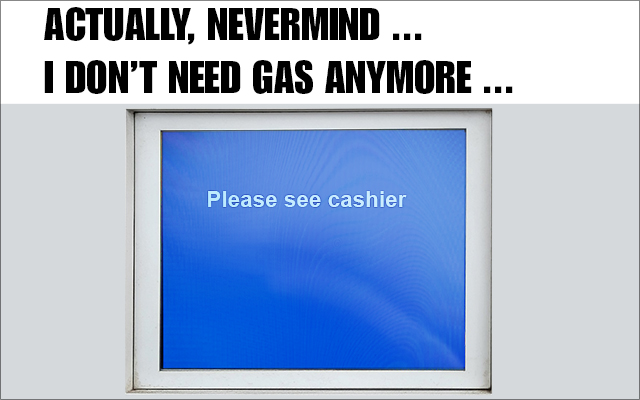Powered by iNFX Learn More
Think about the last time you stopped at a subpar convenience store.
Maybe there’s no tap to pay.
Maybe the chip reader isn’t set up, forcing you to swipe your card.
Or worse...THIS:

You might ask yourself, “how does a retailer get this far behind?”
The answer is simple: they weren't looking ahead five years ago. But don’t worry!
We asked four leading experts to look into the c-store crystal ball of payment.
Here are their insights:
Contactless
Contactless payment, inside and outside the store, has officially moved from a futuristic luxury to an everyday necessity.
“I have two gas stations by my house, same relative costs, same footprint, relative newness,” says Jonathan Langlois, Managing Director, Strategy, KPMG. “One has contactless payment, one doesn't. So, I go to the contactless one.”
The growing preference for contactless solutions underscores the importance of staying current with payment systems. RBR forecasts that 81% of all cards will be contactless by 2026, and that the Americas are expected to experience the fastest growth.
"[Contactless] adoption is growing,” Sean Gately, VP Security Solutions at Bluefin Payment Systems. “So when you are upgrading hardware, make sure you have contactless support built into it.”
Digital Wallets for Loyalty
C-store loyalty programs have lower participation rates compared to other larger retail spaces, but digital wallets could help change that.
Super apps like Apple Pay and Google Wallet can integrate various services including loyalty programs.
“It facilitates the payment and loyalty with one tap,” says David Schuster, Senior Director, Portfolio Manager, Invenco by GVR. “With digital wallets, consumers don’t have to keep up with multiple loyalty apps for multiple stores.”
Real-Time Payments
Today’s payment methods feel fast, but they are far from instantaneous.
Processing delays can distort a business's view of its cash flow and financial health. Real-time payments eliminate these delays, offering a clearer and more immediate financial picture.
"It's finally starting to come to fruition a little bit. We're well behind the rest of the world,” says Langlois. “About 18% of payments outside of the US were made in the real-time payment space. In the U.S., 1.2% of payments were real time payments.”
Due to limited financial incentives, banks have been slow to adopt this technology. Right now, the most popular use-case of real-time payments is sending money from person to person using apps like Zelle.
Security Challenges
Chip cards have helped knock down fraud, but it is not a silver bullet.
“For every brand-new technology or methodology we come up with,” says Gates. “There are 10,000 guys and gals around the world sitting there trying to figure out how to break it.”
Even with EMV, chip cards have flaws if the retailer’s system isn’t properly set up with all safety features functioning.
One of our experts knows first-hand. As a reformed convicted c-store scammer turned consultant, Mike Perez from Unchained Leadership knows criminals will never stop trying to game the system.
“I've even cloned EMV cards," says Perez. “I've been able to do transactions with them because [the terminal] wasn't looking for all the security features.”
The rise of quantum computing could also break current encryption methods, making it crucial for the industry to develop quantum-safe algorithms and update existing infrastructure.
The Bottom Line
Outdated c-store payment tech is easy to spot, even for the average consumer. All four experts agree, retailers must keep their eyes on the future to stay current today.
Embracing advanced payment technologies not only enhances the customer convenience and security but is essential for staying competitive in a rapidly evolving retail landscape.
Invenco by GVR is working hard to bring innovative payment solutions to our customers to ensure they are ready for the future.
The information from this blog was first presented at RTC24. Stay tuned for dates and location for RTC25 to gain early access to information like this.
